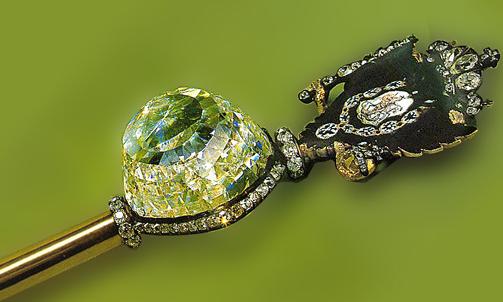The early origin of the exquisite Orloff Diamond – perhaps the fourth largest of cut diamonds – is shrouded in mystery. World authorities debate the exact date of the entry of the Orloff into the history of nations and the lives of men. However, some think it to be the Great Mogul – the fabulous stone but once seen by European eyes – whose present location is unknown.
Orloff Diamond Mounted In The Royal Scepter
The Orloff Diamond: The Story Behind Its Discovery:
The known history of the Orloff diamond began when it served as the eye of an Indian idol. Today, it is among the financial reserves of one of the world’s most powerful nations.
The story of the journey of the Orloff diamond to the Occident from that vast Oriental jewel box in India is of more than passing interest. Near Trichinopoly in Mysore, a native state in Southern India, there is in the river Cauvery an island called Srirangam. Near the island’s western shore, a Hindu temple stood enclosed by seven walls. Within the temple’s innermost shrine stood the idol of the presiding deity. Its eyes were two great gems – one of these the Orloff, a massive diamond of the shape of half an egg and in weight almost 200 carats.
A French grenadier – a deserter – lived in the neighborhood of the temple. He learned of this treasure and devoted many years of his worthless life to gaining possession of it. He must have embraced the Hindu faith, for the rules did not allow any Christian to go beyond the fourth of the seven enclosures of the temple. Gradually, the grenadier obtained employment within the walls. Finally, after many years of carefully planned labor, he was admitted as a frequent worshipper at the inner shrines because of his apparent devotion to God and the priests.
The Orloff Diamond is Stolen & Purchased:
The French soldier laid his plans carefully. Eventually, the moment for which he had waited came. A stormy night. The idol in fitful shadows. He pried one diamond eye from its socket. Then he lost his courage. Leaving the other diamond behind, he fled. He successfully scaled the walls and swam the river. Then, in a raging storm, he escaped through the jungle to the English army – Madras (now Chennai) – and safety.
Subsequently, the ex-soldier found a purchaser for the diamond, at $10,000, in the person of an English sea captain at Madras (now Chennai). The skipper sold the stone for $ 60,000 to a Jewish merchant, who sold it to a notorious Persian scalawag named Khojeh around the year 1775.
A Russian Prince Acquires & Gifts The Orloff Diamond to His Crush:
At this time, the court of Russia was gay and extravagant. Therefore, Khojeh decided to travel to the Russian court to find a buyer for the jewel. He was fortunate: In Amsterdam, while on his journey to the court, Khojeh met the Russian prince Gregory Orloff. The prince had been the lover of Catherine the Great, Empress of the Russias. But at the time, he was out of her favor.
Catherine had a passion for gems; her emeralds formed one of the finest jewel collections in the world, and her love for Amethysts has become a legend. Orloff knew her passion for gems, so it was an easy matter for Kojeh to sell him the great diamond. By presenting it to Catherine, Orloff hoped to win back her favor. Consequently, the Persian could sell the diamond to Orloff for about $450,000 and an annuity of $20,000.
The Orloff Diamond is Mounted On a Royal Sceptor, an Emblem of a Mighty Empire:
The prince presented this gem to Catherine, and she returned other valuable gifts. Nevertheless, Orloff never regained his former high estates. Instead, Catherine had the diamond – now called “Orloff” after its donor – mounted in the royal scepter, and it became the symbol of the sovereignty of a vast empire.
A legend in Russia proclaims that as Napoleon was approaching Moscow, the Russians secreted the Orloff diamond in the tomb of a priest in Kremlin. When Napoleon entered Moscow, he ordered to seek the gem. They learned its hiding place, and Napoleon, in person, accompanied by his bodyguard, proceeded to the Kremlin to seize the stone. They opened the tomb, and the great stone lay before the despoiler. One of the bodyguards extended a hand to take the Orloff, but before he touched the jewel, the ghost of the dead priest rose and cursed the invaders.
Napoleon and his bodyguard were then supposed to have fled from the Kremlin. But there seems to be sufficient reason to believe this incident is untrue. We should doubt that the little Corsican general who had put most of Europe at the feet of his conquering armies would flee before the ghost of a single dead priest.
Where is The Orloff diamond today?
The Orloff survives in the Diamond Treasure of Russia in Moscow. Data released by the Kremlin give the Orlov’s measurements as 32 millimeters x 35 millimeters x 21 millimeters, its weight being 189.62 carats (37.924 g). However, the weight is just an estimate – no one has formally weighed in many years. The Orloff diamond remains mounted in the scepter of Romanoffs. Still, the royal hands of this once mighty family will never again wield the diamond as an emblem of sovereignty.
Read About More Famous Diamonds As Follows:
| The Cullinan Diamond | The Centenary Diamond |
| The Esperanza Diamond | Eureka Diamond |
Or Learn About More Colored Diamonds As Follows::
See Also:
Fascinating Facts About Diamonds Straight From Tiffany & Co’s Chief Gemologist
